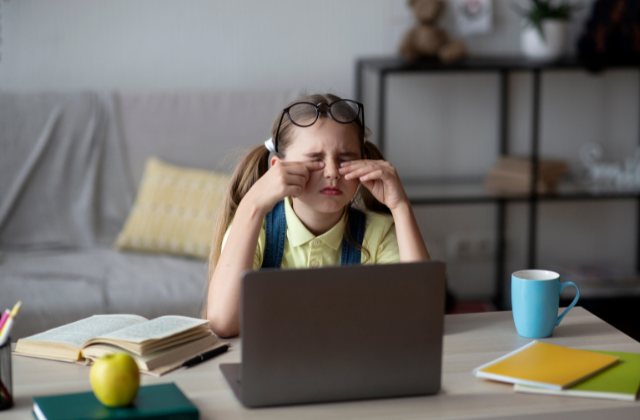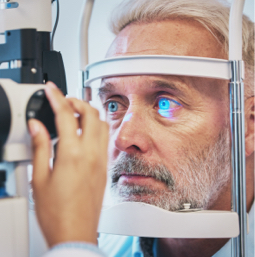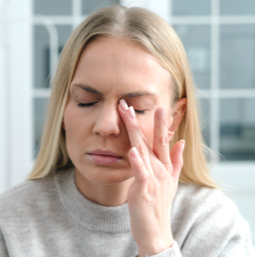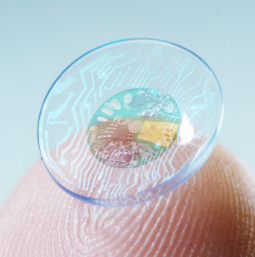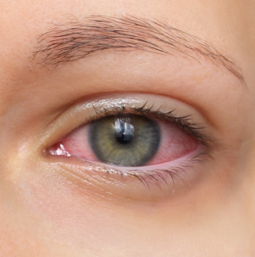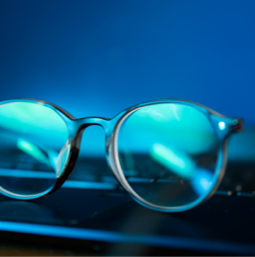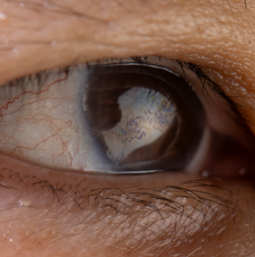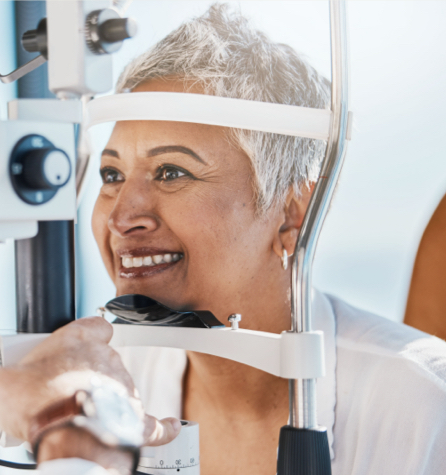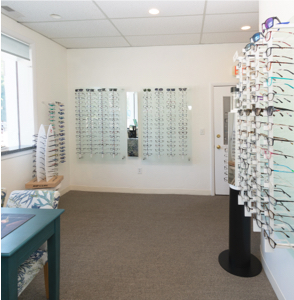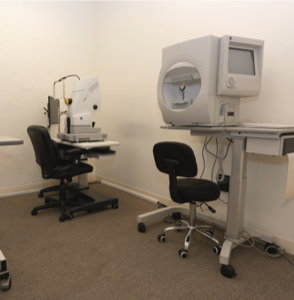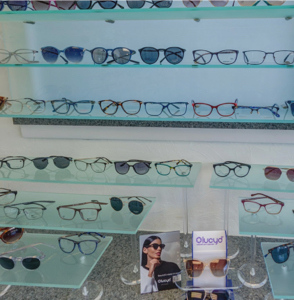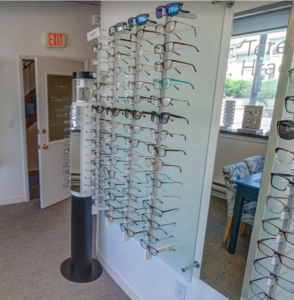Are eye glasses on your back to school shopping list? While the correct glasses prescription ensures clear vision for your student, today’s technologies can also reduce eye strain and prevent future vision problems. Your optometrist can help you choose the best lenses for your child’s eye health during their comprehensive eye exam.

What is Eye Strain?
- Discomfort in the eyes after close-up work
- Symptoms include heaviness, soreness, dry eyes, blurred vision, headaches
Eyestrain is eye discomfort that occurs during intense focusing. With close-up viewing, the lens of the eye contracts. If the lens does not have a chance to relax, the eyes will fatigue. This is why your eyes may feel tired, heavy, or sore after looking at small print, a computer screen, or a cellphone.
Along with heaviness and soreness, eye strain may cause dry eyes. During intense focus, there is a tendency to blink less, exposing the eye’s surface to air and evaporation. This creates holes in the tear film that lead to the stinging or scratchy feeling of dry eyes.
Blinking restributes and replenishes the tear layer, smoothing the surface across the cornea and sharpening your vision. When blinking is reduced when focusing on a screen, the corneal surface becomes irregular and vision is blurred.
With blurred vision, your eye muscles work harder to focus. This overexertion causes headaches that often occur behind the eyes. While eye strain headaches are particularly common after long periods of focus on screens, they also occur after reading or close-up work and may be the result of poor lighting or uncorrected vision.
Eye Strain and Screens
- Pixel brightness impacts focusing, leading to eye strain
Eyestrain is commonly caused by prolonged screen use. Each pixel in the screen image has a bright center that fades toward the periphery, which makes it difficult for human eyes to sustain focus. As the eye works harder, it will fatigue.
Oftentimes, we do not notice the effects of eye strain right away, particularly if the screens are used for entertainment or if there is not a chance to take a break. After focusing for a while, you may become more aware of eye strain symptoms, along with increased tiredness and difficulty concentrating.
Relieving Eye Strain in Children

- Children may not be able to respond effectively to eye strain and need guidance
- “20-20-20” rule: every 20 minutes, shift your eyes to look at an object at least 20 feet away for at least 20 seconds.
- Use artificial tears and hot compresses to relieve dry eyes
- View screens at an arm’s length and at a slight downward angle
- Take breaks from devices and close up work
- Go outdoors or look out the window
While people of all ages are at risk from eye strain from screens, children may be particularly affected since they may not respond effectively to initial signs of discomfort. Studies have shown that even 1 hr of screen use can lead to the onset of visual fatigue, so it is important for everyone to take protective measures against eye strain.
When absorbed in a screen-based activity, children need to be encouraged to blink and relax the shoulders and neck muscles. Devices should be kept at least an arms length away and at a slight downward angle. You can also teach them the “20-20-20” rule: every 20 minutes, shift your eyes to look at an object at least 20 feet away for at least 20 seconds.
If your child experiences dry eyes, artificial tears and hot compresses can provide relief. It is also important to encourage your child to take breaks from devices and close-up activities. Going outside or even looking out the window can relieve the symptoms of eye strain!
Children’s Lenses to Reduce Eye Strain
- Anti-fatigue lenses include a boost of power without the visible line of a bifocal
- Computer Glasses
- Blue Light Blocking lenses
- Low add progressive lenses
In addition to ensuring that your child’s eyeglass or contact lens prescription is accurate, choosing the right lenses for your child can ease the symptoms of eye strain.
Anti-fatigue lenses have a small gradient that increases the power at the bottom of the lens. This boost of plus prescription power slightly relaxes the eye when focusing close-up, preventing eye strain. Unlike bifocal lenses, there is no visible line separating out an area for reading power; so, it is a quick and easy adjustment for the eye.
Eyezen® Kids lenses by Essilor are specifically designed for wearers between the ages of six and twelve years old. At this age, children tend to move their eyes more, using a larger surface of the lens. While standard Single Vision lenses can result in aberrations at the lens periphery, Eyezen® Kids lenses provide greater clarity for young “eye movers.”
Eyezen Kids lenses® also take into account the specific viewing distance and facial features of younger glasses wearers in the lens measurements. By optimizing the near vision distance specific to children and including blue light blocking material in the lens, these lenses are a good option for reducing eye strain.
Varilux® Comfort Max lenses expand the useful vision zone by up to 46%. This allows the wearer to see a given focal point from many angles and can accommodate a broader range of head movements while maintaining focusing on a given object point. With this increased postural flexibility, the wearer can more easily change their posture during prolonged vision tasks, preventing eye strain.
Computer Lenses are a subset of progressive lenses designed specifically for focusing on computer screens. By devoting more space on the lens to the intermediate distance common in computer work (20 to 26 inches away from the face), computer glasses can help reduce eye strain from computer work. They have blue light protection, which some studies have shown to reduce the symptoms of digital eye strain.

Blue Light Protection: Crizal Prevencia
Blue light protection coating may further reduce eye strain. Computer Screens emit blue light that can worsen eye strain, disrupt circadian rhythms and sleep, and may even cause long-term damage to retinal cells, leading to vision problems such as age-related macular degeneration.
Not all blue light is harmful. While blue-violet light from the sun and digital devices can damage the photoreceptor cells, blue-turquoise light can stimulate the eye’s pupillary reflex and produce melatonin for improved cognitive performance and regulate the sleep-wake cycle.
Crizal Prevencia partially absorbs harmful blue-violet light and converts it into unperceived heat while the beneficial blue-turquoise light passes through the lens.
Tips for Preventing Eye Strain during Computer Work
Along with Anti-fatigue lenses and blue light protection, there are simply ways to relieve digital eye strain for children, teens, and adults.
- Utilize a blue light screen filter
- Take frequent breaks when working on screens
- Find a computer monitor that promotes eye health
- Set up your computer screen with the optimal viewing distance: optimally, the computer screen should be 15 to 20 degrees below eye level (about 4 or 5 inches) as measured from the center of the screen and 20 to 28 inches from the eyes.
- Practice Blink training: Place your finger gently on the bone to the outside corner of one eye; when blinking you should feel very little movement from the muscles around your eye. Close both eyes normally for 2 seconds and open. Then, aggressively squeeze the lids together (as if you are trying to crack a walnut with your lids) for 2 seconds. Open eyes.
It may be easy to ignore digital eye strain, but addressing the causes of eye strain can have an impact on your long-term eye health. Talk about more ways to relieve and prevent digital eye strain during your next eye exam.

